Photo Essay from South Asia (3)
Welcome to My Study Villages!
Takashi Kurosaki
Last Revised August 27, 2001 (Japanese version: October 27, 1997)
I owe much to fellow villagers from whom I obtained research ideas as well as data for analysis. In this page, I would like to introduce my study villages to appreciate them. The first group of villages belong to Farooqabad, Shekhupura District, Pakistan's Punjab. My Ph.D. Dissertation and my English book (Risk and Household Behavior in Pakistan's Agriculture) are based on data from these villages. The second group of villages are located in Peshawar District, the North-West Frontier Province (NWFP), Pakistan.
Villages in Farooqabad
Farooqabad is a small town on the Indus Plain, about 1.5 hours drive on Lahore-Sargodha national highway. The first visit to this area was arranged by the Punjab Economic Research Institute, Lahore, which implemented a successive household survey with a survey base in this town.
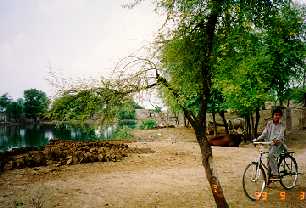 This picture taken in 1993 shows Padiyanwala Village, which is about 2 or 3 km inside from the highway. In this village, a caste called Gujjar is strong. Gujjars are known as cow keeper. Currently, many of them are engaged in dairying. You can see cow-dung for fuel in front of the village pond (Livestock page).
This picture taken in 1993 shows Padiyanwala Village, which is about 2 or 3 km inside from the highway. In this village, a caste called Gujjar is strong. Gujjars are known as cow keeper. Currently, many of them are engaged in dairying. You can see cow-dung for fuel in front of the village pond (Livestock page).
In this area, an aromatic rice called Basmati is the most important crop in summer and wheat is the most important in winter. In addition, farmers grow a lot of green fodder crops, such as sorghum and Egyptian clover to keep bovine livestock.
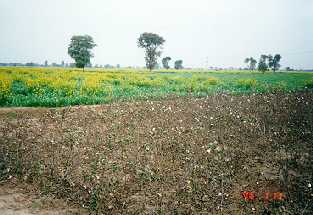 Personally, I like winter times the best in these villages. The weather is comfortable and fields are beautiful with green spotted with yellow and white, as you can see from this picture taken in 1996 in fields between Village Padiyanwala and Village Thatta-Bahadur-Shah. The white crop is cotton with its last harvest; the yellow color comes from Sarsoon, which is reported as "rape and mustard" in government publications in English. This is a very useful crop---mustard oil is extracted from its seeds, seed cakes are fed to milk animals, young plants are served to humans as vegetables and old plants are fed to livestock as fodder.
Personally, I like winter times the best in these villages. The weather is comfortable and fields are beautiful with green spotted with yellow and white, as you can see from this picture taken in 1996 in fields between Village Padiyanwala and Village Thatta-Bahadur-Shah. The white crop is cotton with its last harvest; the yellow color comes from Sarsoon, which is reported as "rape and mustard" in government publications in English. This is a very useful crop---mustard oil is extracted from its seeds, seed cakes are fed to milk animals, young plants are served to humans as vegetables and old plants are fed to livestock as fodder.
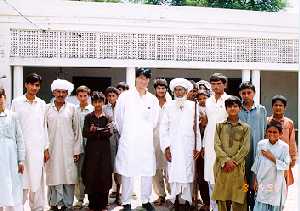 After interviews and seeing around villages, villagers gathered around, as you can see from the photo (left). It was taken in Village Thatta-Bahadur-Shah in September 1996. You can find myself in Pakistani dress.
After interviews and seeing around villages, villagers gathered around, as you can see from the photo (left). It was taken in Village Thatta-Bahadur-Shah in September 1996. You can find myself in Pakistani dress.
Three Villages in Peshawar
I began to survey three villages in Peshawar District, the North-West Frontier Province (NWFP), in 1996. NWFP is a province around the ancient city of Peshawar, which is on the route to Afghanistan. The three villages are in sharp contrast with respect to economic development and agricultural environment.
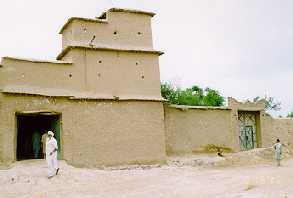 Village A is the farthest one from Peshawar --- after more than one hour drive on highways, the final drive on unpaved road for 4km took more than half an hour. For villagers, it takes more than three hours to reach Peshawar by foot and public transportation. When I visited the village for the first time in August 1996, I was impressed with its barren-like view. Most of the fields were dry, although the month I visited was the end of "Monsoon" season. The village is completely rain-fed, unlike my earlier study villages in Punjab.
Village A is the farthest one from Peshawar --- after more than one hour drive on highways, the final drive on unpaved road for 4km took more than half an hour. For villagers, it takes more than three hours to reach Peshawar by foot and public transportation. When I visited the village for the first time in August 1996, I was impressed with its barren-like view. Most of the fields were dry, although the month I visited was the end of "Monsoon" season. The village is completely rain-fed, unlike my earlier study villages in Punjab.
The picture above (left) shows a house of one of the most important families in the village. The first floor is completely surrounded by a wall so that outsiders cannot offend women in the backyard of the house. The third story has several holes in the wall: they are watching holes sometimes used as gun holes to evict unwanted visitors. Holding a gun is a proud symbol of a male adult in this region.
 The photo (right) shows the center of the village. Main street is on its center; a recently-built Mosque is shown on the right hand side; and a bus stop is on the left hand side. In this place, we made a household list and interviewed sample households.
The photo (right) shows the center of the village. Main street is on its center; a recently-built Mosque is shown on the right hand side; and a bus stop is on the left hand side. In this place, we made a household list and interviewed sample households.
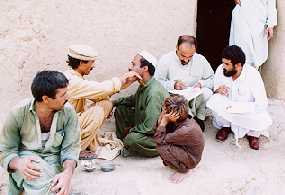 This picture (left) shows a barber shaving his customer as well as answering my investigator's questions. A barber in a traditional village was paid in kind by farm households twice annually after harvest (i.e., he did not get reward for each service separately). This practice was still observed in this village in 1996.
This picture (left) shows a barber shaving his customer as well as answering my investigator's questions. A barber in a traditional village was paid in kind by farm households twice annually after harvest (i.e., he did not get reward for each service separately). This practice was still observed in this village in 1996.
Since our survey put emphasis on livelihood of non-farm households, this barber was also interviewed and analyzed in my reports. Our investigator is shown in the photo, who takes notes behind the barber.
 Interviews were sometimes done in a guest space called Hujra, which is shown in this photo. Pashtun people put high priority in welcoming guests. At the same time, they regard the seclusion of women from outsiders as one of the most important social codes. To have a Hujra serves both purposes, because guests can relax there without any chance to see women inside.
Interviews were sometimes done in a guest space called Hujra, which is shown in this photo. Pashtun people put high priority in welcoming guests. At the same time, they regard the seclusion of women from outsiders as one of the most important social codes. To have a Hujra serves both purposes, because guests can relax there without any chance to see women inside.
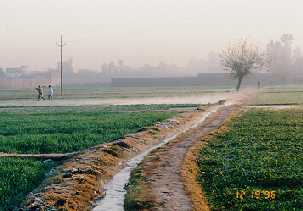 Other two villages are more like Punjabi villages thanks to irrigation. At the same time when dry dust attacks Village A, green crops are grown on fields in Village B and Village C. The photo on the left shows a winter morning scene from Village C. With chilly morning air, steams come out from the field.
Other two villages are more like Punjabi villages thanks to irrigation. At the same time when dry dust attacks Village A, green crops are grown on fields in Village B and Village C. The photo on the left shows a winter morning scene from Village C. With chilly morning air, steams come out from the field.
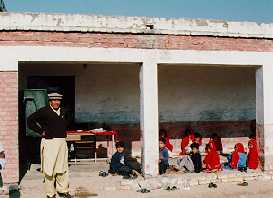 This photo on the right shows a female primary school in Village B in winter. In Pakistan, public primary schools are sex-separated. Male schools are open whereas female schools are walled around. When I visited this female school, I waited for a couple of minutes before entering the school area so that female students in upper grades had enough time to hide.
This photo on the right shows a female primary school in Village B in winter. In Pakistan, public primary schools are sex-separated. Male schools are open whereas female schools are walled around. When I visited this female school, I waited for a couple of minutes before entering the school area so that female students in upper grades had enough time to hide.
Back to Mariamma's Homepage (Information on South Asia): HOME; English Index
Back to Tak's University Homepage
 This picture taken in 1993 shows Padiyanwala Village, which is about 2 or 3 km inside from the highway. In this village, a caste called Gujjar is strong. Gujjars are known as cow keeper. Currently, many of them are engaged in dairying. You can see cow-dung for fuel in front of the village pond (Livestock page).
This picture taken in 1993 shows Padiyanwala Village, which is about 2 or 3 km inside from the highway. In this village, a caste called Gujjar is strong. Gujjars are known as cow keeper. Currently, many of them are engaged in dairying. You can see cow-dung for fuel in front of the village pond (Livestock page).  Personally, I like winter times the best in these villages. The weather is comfortable and fields are beautiful with green spotted with yellow and white, as you can see from this picture taken in 1996 in fields between Village Padiyanwala and Village Thatta-Bahadur-Shah. The white crop is cotton with its last harvest; the yellow color comes from Sarsoon, which is reported as "rape and mustard" in government publications in English. This is a very useful crop---mustard oil is extracted from its seeds, seed cakes are fed to milk animals, young plants are served to humans as vegetables and old plants are fed to livestock as fodder.
Personally, I like winter times the best in these villages. The weather is comfortable and fields are beautiful with green spotted with yellow and white, as you can see from this picture taken in 1996 in fields between Village Padiyanwala and Village Thatta-Bahadur-Shah. The white crop is cotton with its last harvest; the yellow color comes from Sarsoon, which is reported as "rape and mustard" in government publications in English. This is a very useful crop---mustard oil is extracted from its seeds, seed cakes are fed to milk animals, young plants are served to humans as vegetables and old plants are fed to livestock as fodder. After interviews and seeing around villages, villagers gathered around, as you can see from the photo (left). It was taken in Village Thatta-Bahadur-Shah in September 1996. You can find myself in Pakistani dress.
After interviews and seeing around villages, villagers gathered around, as you can see from the photo (left). It was taken in Village Thatta-Bahadur-Shah in September 1996. You can find myself in Pakistani dress.
 Village A is the farthest one from Peshawar --- after more than one hour drive on highways, the final drive on unpaved road for 4km took more than half an hour. For villagers, it takes more than three hours to reach Peshawar by foot and public transportation. When I visited the village for the first time in August 1996, I was impressed with its barren-like view. Most of the fields were dry, although the month I visited was the end of "Monsoon" season. The village is completely rain-fed, unlike my earlier study villages in Punjab.
Village A is the farthest one from Peshawar --- after more than one hour drive on highways, the final drive on unpaved road for 4km took more than half an hour. For villagers, it takes more than three hours to reach Peshawar by foot and public transportation. When I visited the village for the first time in August 1996, I was impressed with its barren-like view. Most of the fields were dry, although the month I visited was the end of "Monsoon" season. The village is completely rain-fed, unlike my earlier study villages in Punjab. The photo (right) shows the center of the village. Main street is on its center; a recently-built Mosque is shown on the right hand side; and a bus stop is on the left hand side. In this place, we made a household list and interviewed sample households.
The photo (right) shows the center of the village. Main street is on its center; a recently-built Mosque is shown on the right hand side; and a bus stop is on the left hand side. In this place, we made a household list and interviewed sample households.  This picture (left) shows a barber shaving his customer as well as answering my investigator's questions. A barber in a traditional village was paid in kind by farm households twice annually after harvest (i.e., he did not get reward for each service separately). This practice was still observed in this village in 1996.
This picture (left) shows a barber shaving his customer as well as answering my investigator's questions. A barber in a traditional village was paid in kind by farm households twice annually after harvest (i.e., he did not get reward for each service separately). This practice was still observed in this village in 1996. Interviews were sometimes done in a guest space called Hujra, which is shown in this photo. Pashtun people put high priority in welcoming guests. At the same time, they regard the seclusion of women from outsiders as one of the most important social codes. To have a Hujra serves both purposes, because guests can relax there without any chance to see women inside.
Interviews were sometimes done in a guest space called Hujra, which is shown in this photo. Pashtun people put high priority in welcoming guests. At the same time, they regard the seclusion of women from outsiders as one of the most important social codes. To have a Hujra serves both purposes, because guests can relax there without any chance to see women inside. Other two villages are more like Punjabi villages thanks to irrigation. At the same time when dry dust attacks Village A, green crops are grown on fields in Village B and Village C. The photo on the left shows a winter morning scene from Village C. With chilly morning air, steams come out from the field.
Other two villages are more like Punjabi villages thanks to irrigation. At the same time when dry dust attacks Village A, green crops are grown on fields in Village B and Village C. The photo on the left shows a winter morning scene from Village C. With chilly morning air, steams come out from the field. This photo on the right shows a female primary school in Village B in winter. In Pakistan, public primary schools are sex-separated. Male schools are open whereas female schools are walled around. When I visited this female school, I waited for a couple of minutes before entering the school area so that female students in upper grades had enough time to hide.
This photo on the right shows a female primary school in Village B in winter. In Pakistan, public primary schools are sex-separated. Male schools are open whereas female schools are walled around. When I visited this female school, I waited for a couple of minutes before entering the school area so that female students in upper grades had enough time to hide.